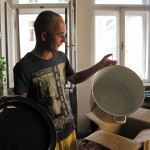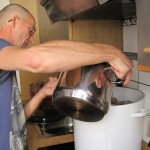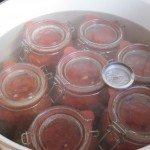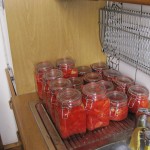Preserving tomatoes
It might seem old fashioned or even unnecessary but there are reasons why we make our own preserved tomatoes:
- control over ingredients
- support of local producers
- quality of result
- fun
This year we planned the thing in advance. First we asked our favorite vegetable dealer at the market when he would be able to deliver about 10kg of really ripe tomatoes. When his plants had produced what we wanted we went to get them.
Next thing is cleaning the kitchen since we would need all the space available (our kitchen is really small). Then we set up an assembly line from right to left - more or less. Reni’s job was cutting the tomatoes, mine was to fill the jars. The recipe is quite simple: cut tomatoes into slices (quarters). Stuff them into the jar. Add hot water (with a jug of vinegar and some salt). Close the jar. Cook it. Done.
Before using them we cleaned the jars, added a fresh rubber seal and put each one into boiling water (also with some vinegar added) for a moment or two.
The cooking in the big pot needs time. I usually add enough water so all the jars are nicely covered although a lot of people say it is sufficient if the top layer of jars is about two third deep in water. The water should have around 90 degrees celsius. Leave everything in for at least an hour. Then take out the jars, let them cool off and check if they are tightly sealed. This way you should have killed all the germs that might otherwise destroy the tomatoes.
The cooking also tightly closes the jars. Because the content inside each jar is heated it expands. It will push remaining air out of the jar since the seal will let it. When cooling, the entire contents of the jar shrinks a little resulting in less pressure inside than outside. If a jar opens you should keep it in the fridge and eat the contents as soon as possible.






